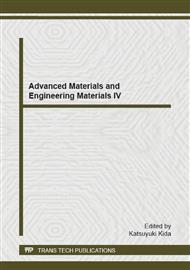[1]
M. Janulikova, R. Cajka, P. Mateckova, V. Buchta, Laboratory Testing of Asphalt Belts Rheological Properties Exposed to Shear Loads, Transactions of the VŠB - Technical University of Ostrava, Civil Engineering Series, vol. XII, iss. 2, p.59–66 (8 p), ISSN (Online) 1804-4824, ISSN (Print) 1213-1962, DOI: 10. 2478/v10160-012-0018-2, January (2013).
DOI: 10.2478/v10160-012-0018-2
Google Scholar
[2]
M. Janulikova, Behavior of Selected Materials to Create Sliding Joint in the Foundation Structure, Advanced Materials Research, vols. 838 – 841, p.454 – 457 (4 p), Trans Tech Publications, Switzerland, ISSN (Online) 1662-8985, ISSN (Print) 1022-6680, DOI: 10. 4028/www. scientific. net/AMR. 838-841. 454, (2014).
DOI: 10.4028/www.scientific.net/amr.838-841.454
Google Scholar
[3]
M. Janulikova, M. Stara, Multi-layer Rheological Sliding Joint in the Foundation Structures, Transactions of the VŠB – Technical University of Ostrava, Civil Engineering Series, vol. XIII, iss. 2, p.41–46 (6 p), ISSN (Online) 1804-4824, ISSN (Print) 1213-1962, DOI: 10. 2478/tvsb-2013-0008, December (2013).
DOI: 10.2478/tvsb-2013-0008
Google Scholar
[4]
M. Janulikova, Comparison of the Shear Resistance in the Sliding Joint Between Asphalt Belts and Modern PVC Foils, Applied Mechanics and Materials, vols. 501 – 504, pp.945-948 (4 p), Trans Tech Publications, Switzerland, ISSN (Online) 1662-7482, ISSN (Print) 1660-9336, DOI: 10. 4028/www. scientific. net/AMM. 501-504. 945, (2014).
DOI: 10.4028/www.scientific.net/amm.501-504.945
Google Scholar
[5]
M. Janulikova, M. Stara, Reducing the Shear Stress in the Footing Bottom of Concrete and Masonry Structures, Procedia Engineering, vol. 65, p.284 – 289 (4 p), ISSN 1877-7058, DOI: 10. 1016/j. proeng. 2013. 09. 044, (2013).
DOI: 10.1016/j.proeng.2013.09.044
Google Scholar
[6]
R. Cajka, R. Fojtik, Development of Temperature and Stress during Foundation Slab Concreting of National Supercomputer Centre IT4, Procedia Engineering, vol. 65, pp.230-235 (6 p), ISSN 1877-7058, DOI: 10. 1016/j. proeng. 2013. 09. 035, (2013).
DOI: 10.1016/j.proeng.2013.09.035
Google Scholar
[7]
M. Krejsa, R. Cajka, The foundation slab monitoring of the National Supercomputing Center - IT4 Innovations, during construction. In: Proceedings of the 11th International Probabilistic Workshop 2013 (IPW11), Brno, Czech Republic, ISBN 978-80-214-4800-1, (2013).
Google Scholar
[8]
R. Cajka, K. Burkovic, V. Buchta, Foundation Slab in Interaction with Subsoil, Advanced Materials Research, vols. 838-841, pp.375-380 (6 p), Trans Tech Publications, Switzerland, ISSN (Online) 1662-8985, ISSN (Print) 1022-6680, DOI: 10. 4028/www. scientific. net/AMR. 838-841. 375, (2014).
DOI: 10.4028/www.scientific.net/amr.838-841.375
Google Scholar
[9]
R. Cajka, K. Burkovic, V. Buchta, R. Fojtik, Experimental soil - Concrete plate interaction test and numerical models, Key Engineering Materials, vols. 577 - 578, pp.33-36 (4 p), Trans Tech Publications, Switzerland, ISSN (Online) 1662-9795, ISSN (Print) 1013-9826, DOI: 10. 4028/www. scientific. net/KEM. 577-578. 33, (2014).
DOI: 10.4028/www.scientific.net/kem.577-578.33
Google Scholar
[10]
V. Buchta, P. Mynarcik, Experimental testing of fiberconcrete foundation slab model, Applied Mechanics and Materials, vols. 501 – 504, pp.291-294 (4 p), Trans Tech Publications, Switzerland, ISSN (Online) 1662-7482, ISSN (Print) 1660-9336, DOI: 10. 4028/www. scientific. net/AMM. 501-504. 291, (2014).
DOI: 10.4028/www.scientific.net/amm.501-504.291
Google Scholar
[11]
M. Stara, M. Janulikova, Laboratory measurements and numerical modeling of pre-stressed masonry, Procedia Engineering, vol. 65, pp.411-416 (6 p), ISSN 1877-7058, DOI: 10. 1016/j. proeng. 2013. 09. 064, (2013).
DOI: 10.1016/j.proeng.2013.09.064
Google Scholar
[12]
P. Mynarcik, Technology and Trends of Concrete Industrial Floors, Procedia Engineering, vol. 65, pp.107-112 (6 p), ISSN 1877-7058, DOI: 10. 1016/j. proeng. 2013. 09. 019, (2013).
DOI: 10.1016/j.proeng.2013.09.019
Google Scholar
[13]
R. Cajka, Accuracy of Stress Analysis Using Numerical Integration of Elastic Half-Space, Applied Mechanics and Materials, vols. 300-301, pp.1127-1135 (9 p), Trans Tech Publications, Switzerland, ISSN (Online) 1662-7482, ISSN (Print) 1660-9336, DOI: 10. 4028/www. scientific. net/AMM. 300-301. 1127, (2013).
DOI: 10.4028/www.scientific.net/amm.300-301.1127
Google Scholar
[14]
J. Bradac et. al., Design constructed facilities in mining subsidence areas. Comment on the standard CSN 73 0039, 136 p, Prague standard publications, ISBN 80-85111-19-5, Prague, 1991. (in Czech).
Google Scholar
[15]
P. Manasek, Foundation structures with sliding joint. Ostrava: 2008. PhD. thesis, VŠB-Technical University of Ostrava, Faculty of Civil Engineering, Department of Building Structures, 89 p, 2008. (in Czech).
DOI: 10.17512/znb.2017.1.22
Google Scholar
[16]
CSN 73 0039. Design constructed facilities in mining subsidence areas. Basic requirements. CEN Brussels, (1989).
Google Scholar


